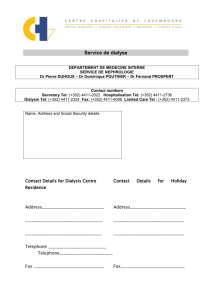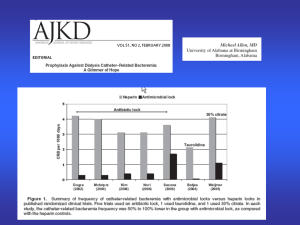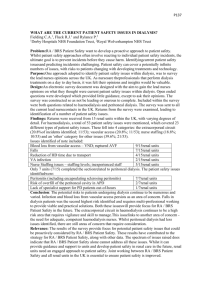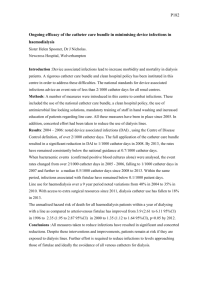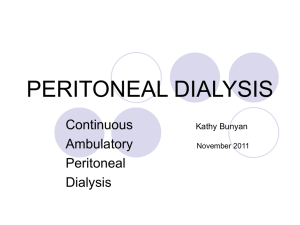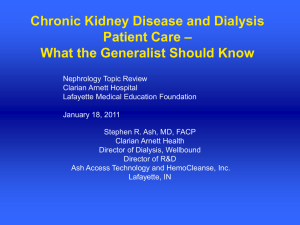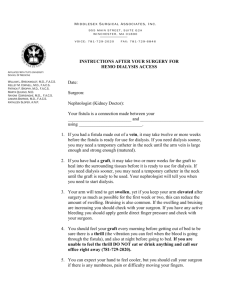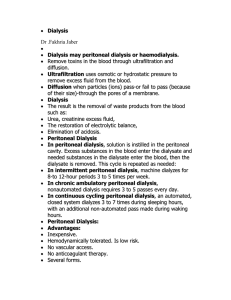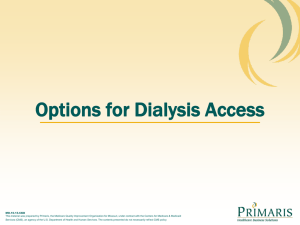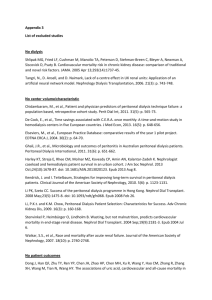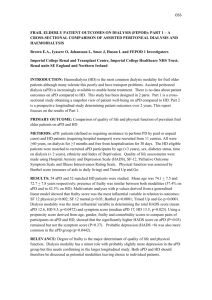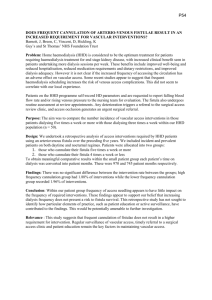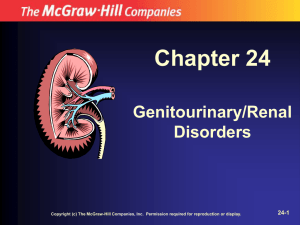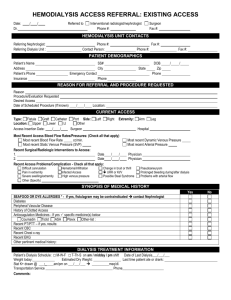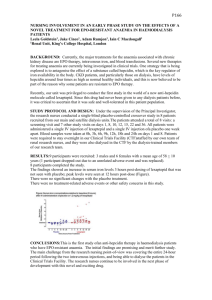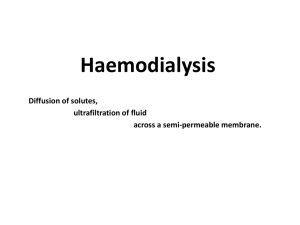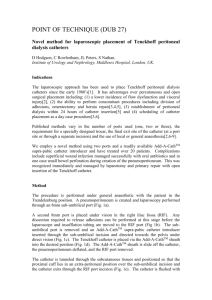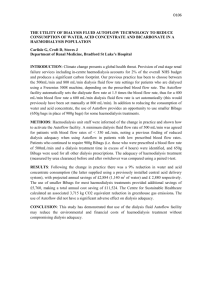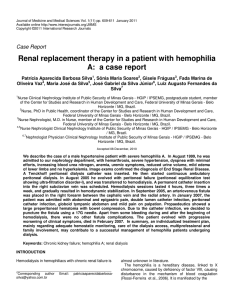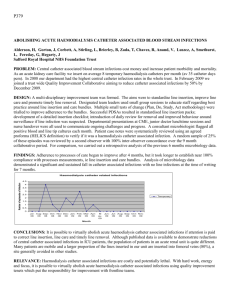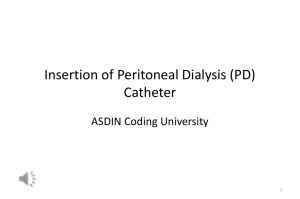a service evolution - British Renal Society
advertisement
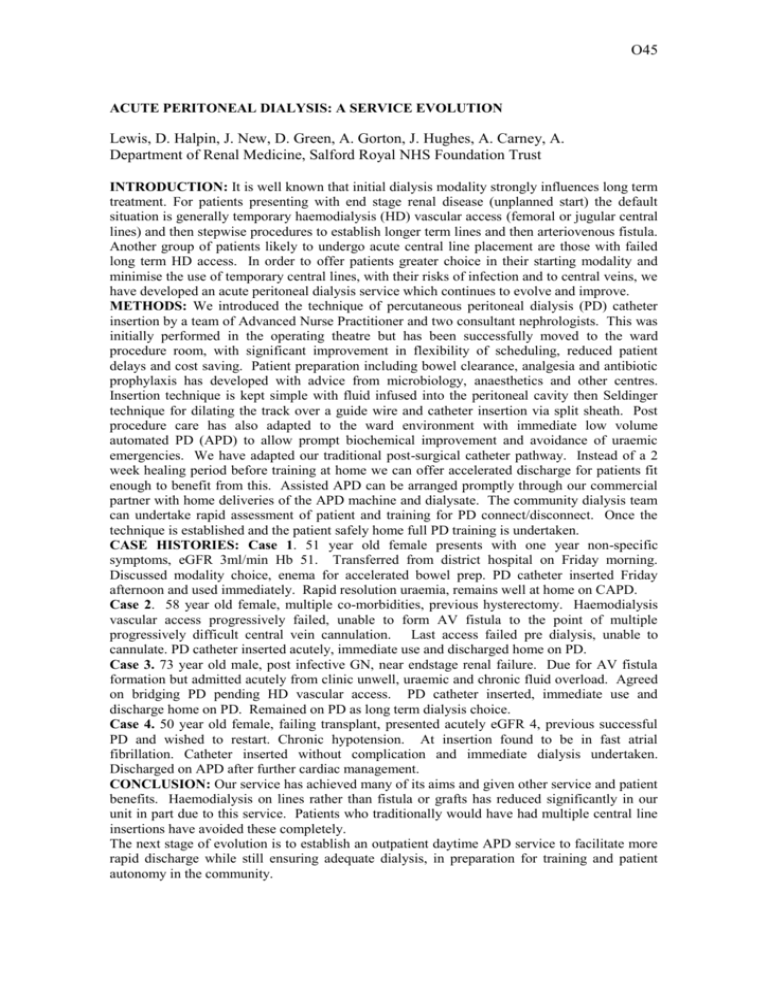
O45 ACUTE PERITONEAL DIALYSIS: A SERVICE EVOLUTION Lewis, D. Halpin, J. New, D. Green, A. Gorton, J. Hughes, A. Carney, A. Department of Renal Medicine, Salford Royal NHS Foundation Trust INTRODUCTION: It is well known that initial dialysis modality strongly influences long term treatment. For patients presenting with end stage renal disease (unplanned start) the default situation is generally temporary haemodialysis (HD) vascular access (femoral or jugular central lines) and then stepwise procedures to establish longer term lines and then arteriovenous fistula. Another group of patients likely to undergo acute central line placement are those with failed long term HD access. In order to offer patients greater choice in their starting modality and minimise the use of temporary central lines, with their risks of infection and to central veins, we have developed an acute peritoneal dialysis service which continues to evolve and improve. METHODS: We introduced the technique of percutaneous peritoneal dialysis (PD) catheter insertion by a team of Advanced Nurse Practitioner and two consultant nephrologists. This was initially performed in the operating theatre but has been successfully moved to the ward procedure room, with significant improvement in flexibility of scheduling, reduced patient delays and cost saving. Patient preparation including bowel clearance, analgesia and antibiotic prophylaxis has developed with advice from microbiology, anaesthetics and other centres. Insertion technique is kept simple with fluid infused into the peritoneal cavity then Seldinger technique for dilating the track over a guide wire and catheter insertion via split sheath. Post procedure care has also adapted to the ward environment with immediate low volume automated PD (APD) to allow prompt biochemical improvement and avoidance of uraemic emergencies. We have adapted our traditional post-surgical catheter pathway. Instead of a 2 week healing period before training at home we can offer accelerated discharge for patients fit enough to benefit from this. Assisted APD can be arranged promptly through our commercial partner with home deliveries of the APD machine and dialysate. The community dialysis team can undertake rapid assessment of patient and training for PD connect/disconnect. Once the technique is established and the patient safely home full PD training is undertaken. CASE HISTORIES: Case 1. 51 year old female presents with one year non-specific symptoms, eGFR 3ml/min Hb 51. Transferred from district hospital on Friday morning. Discussed modality choice, enema for accelerated bowel prep. PD catheter inserted Friday afternoon and used immediately. Rapid resolution uraemia, remains well at home on CAPD. Case 2. 58 year old female, multiple co-morbidities, previous hysterectomy. Haemodialysis vascular access progressively failed, unable to form AV fistula to the point of multiple progressively difficult central vein cannulation. Last access failed pre dialysis, unable to cannulate. PD catheter inserted acutely, immediate use and discharged home on PD. Case 3. 73 year old male, post infective GN, near endstage renal failure. Due for AV fistula formation but admitted acutely from clinic unwell, uraemic and chronic fluid overload. Agreed on bridging PD pending HD vascular access. PD catheter inserted, immediate use and discharge home on PD. Remained on PD as long term dialysis choice. Case 4. 50 year old female, failing transplant, presented acutely eGFR 4, previous successful PD and wished to restart. Chronic hypotension. At insertion found to be in fast atrial fibrillation. Catheter inserted without complication and immediate dialysis undertaken. Discharged on APD after further cardiac management. CONCLUSION: Our service has achieved many of its aims and given other service and patient benefits. Haemodialysis on lines rather than fistula or grafts has reduced significantly in our unit in part due to this service. Patients who traditionally would have had multiple central line insertions have avoided these completely. The next stage of evolution is to establish an outpatient daytime APD service to facilitate more rapid discharge while still ensuring adequate dialysis, in preparation for training and patient autonomy in the community.
